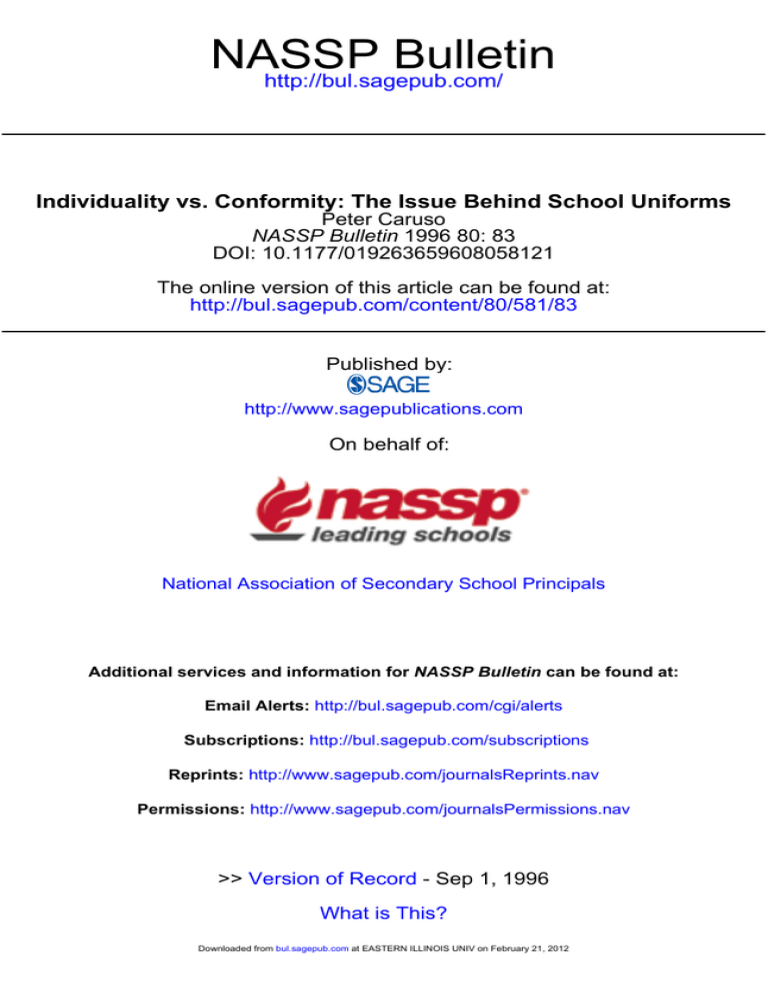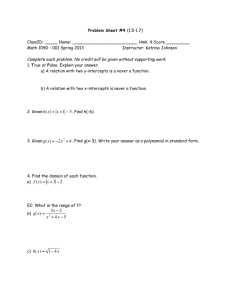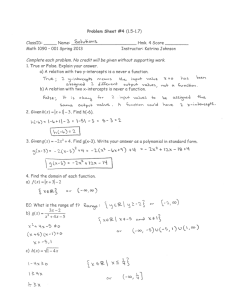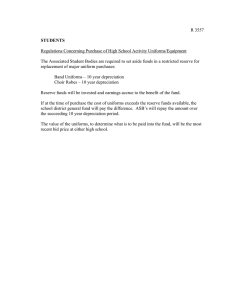Individuality vs. Conformity: The Issue Behind School Uniforms
advertisement

NASSP Bulletin http://bul.sagepub.com/ Individuality vs. Conformity: The Issue Behind School Uniforms Peter Caruso NASSP Bulletin 1996 80: 83 DOI: 10.1177/019263659608058121 The online version of this article can be found at: http://bul.sagepub.com/content/80/581/83 Published by: http://www.sagepublications.com On behalf of: National Association of Secondary School Principals Additional services and information for NASSP Bulletin can be found at: Email Alerts: http://bul.sagepub.com/cgi/alerts Subscriptions: http://bul.sagepub.com/subscriptions Reprints: http://www.sagepub.com/journalsReprints.nav Permissions: http://www.sagepub.com/journalsPermissions.nav >> Version of Record - Sep 1, 1996 What is This? Downloaded from bul.sagepub.com at EASTERN ILLINOIS UNIV on February 21, 2012 FEATURES Individuality vs. Conformity: The Issue Behind School Uniforms By Peter Caruso When icy, we we implement a school uniform potunderstand the validity of each proponent’s arguments. consider whether need to Do school uniforms make hose or not to difference a or not? in favor of uniforms claim there are many advantages to instiacademic them: improved performance, student safety, student ~ tuting and school morale as well as a decrease in clothing costs discipline, for parents. Those who oppose this idea claim that such a policy violates the First Amendment and that educators and schools will not see the dramatic effects its advocates claim. At this time school uniforms do Long Beach Unified School District seem to be making a difference. The (the first public school system in the uniforms) is one example. Officials in country to require students to wear the district maintain that they have seen large increases in attendance and test scores as well as decreases in crime and discipline problems among their 58,500 students. &dquo;Uniforms really level the playing field between the haves and have-nots,&dquo; said district spokesperson Richard Van Der Laan. He also said the school district has sought financing from community service groups, businesses, and individuals to help poor families obtain uniforms. According to district teachers the uniforms have created a better classroom/learning environment by curbing gang tension and the polarization associated with name brand clothing. Overall school crime throughout the district is down 36 percent; student suspensions are down 32 per- required approval from two-thirds of the parents before implemented the policy, which Van Der Laan states has spurred parent cent. it The district involvement. At Whittier a particularly Peter Caruso is a Elementary School in the poor and transient school in have been the uniforms Long Beach district, neighborhood, a junior high school English teacher in Mesa, Ariz. Downloaded from bul.sagepub.com at EASTERN ILLINOIS UNIV on February 21, 2012 83 required for five years. Student attendance has risen each year, to a high of 96 percent. They now boast the highest attendance record in the district. Whittier’s Vice Principal Wendy Claflin says that the uniforms protect students from gangs and other students to school. so Whittier students are not afraid to come Schools in Chicago, Florida, Georgia, Louisiana, Maryland, New York, Virginia have also made similar claims. A Maryland junior high school principal and his colleagues observed an increase in the number of students and on the honor roll after the instituted. Another principal noted a decrease in the number of disputes among students and an significant policy was increase in positive student interactions. Principals in Chicago noted a striking decrease in the number of discipline incidents since a uniform policy has been adopted. But rienced so why have schools that have much success? implemented a uniform policy expe,_ Arguments for Uniforms _, ,&dquo;’, y ~ . ’ 1. School uniforms increase student attendance. . Both administrators and students have stated that students often delay or not purchase books or school supplies because they were saving their money for clothing, accessories, and hairstyles. Others said they would skip school, work long hours, or even participate in illegal activities to obtain a fashionable wardrobe. When this competitive aspect was removed, students claimed it was easier to come to school. would 2. School trating uniforms cut down on distractions that keep students from concen- on their lessons. Outside factors can distract students from education, the primary purpose of school. Today children as young as six are concerned about &dquo;looking cool&dquo; in school. Where does learning fit into this priority? A school uniform eliminates competition to have the most desirable cloth- ing. When all students cerned about how they are wearing the same outfit, they are less con- look and how they fit in with their peers; thus, their schoolwork, and parents and teachers can about that distraction. they can concentrate on stop worrying 3. Uniforms increase student self-confidence and esteem. Students may develop strong feelings of inferiority when they feel they do not have the &dquo;right&dquo; clothes. They are often prejudiced against classmates who do not have clothes with popular brand names or who wear hand-me-downs. This attitude, whether deliberate or accidental, is destrucDownloaded from bul.sagepub.com at EASTERN ILLINOIS UNIV on February 21, 2012 84 tive for those who hold it and is often Uniforms eliminate this devastating for the recipients. prejudice. 4. School uniforms produce an esprit de corps among students. A school uniform creates a feeling of belonging within the school. Experts in psychology generally agree that clothing and appearance influence individual and group behavior. Clothing can provide clues to the status of persons or groups as well as being a reflection of values. If all students are dressed the same, these ideas are no longer an issue of importance to students. A uniform can build the same feeling of unity and belonging that many students get from team uniforms, cheerleading outfits, or school jackets. 5. School uniforms decrease clothing costs. Once a uniform style is decided upon, the school can take bulk orders to purchase uniforms at cost, or charge enough to make a small profit, devoting the proceeds to school activities or to students who are unable afford them. The uniforms for the year will cost far less than students under peer pressure would feel driven to spend for a year’s wardrobe. Uniforms would also carry over to the following year, provided they still fit, unlike a student’s current wardrobe that needs to be constantly updated to to keep changing fashions. Chicago, some businesses up with that support the idea of school uniforms have contributed to schools that adopt a uniform policy to offset the costs for parents; in some cases they have taken on the entire cost. In In California, some parent groups have gone so far as to create their line of uniforms for the school and used the proceeds to provide for school needs. A school uniform may also reduce transportation costs, since there is no longer a need to shop for school clothes. own 6. School uniforms can improve classroom behavior. Clothing influences the way students see themselves. Uniforms encourage them to live up to a group standard. Many teachers have found there has been a decrease in the amount of time spent on classroom discipline issues since the institution of school uniforms. In many cases, teachers report that they need not look for violations of the uniform policy because the students police it themselves and report violations to adminis- trators or teachers. 7. School uniforms remove some of the causes of school crime, violence, gang activity. Some students view school latest and fashions, as an arena and students have been killed within which or display the gravely injured by other to Downloaded from bul.sagepub.com at EASTERN ILLINOIS UNIV on February 21, 2012 85 students who covet what they are wearing. Competition over appearance can result in taunts, fights, thefts, and even murder. This occurs not only among enrolled students but also among non-enrolled peers. Students whose families cannot afford to buy them the clothes they want may turn to illegal activities to get the money to buy these items. In schools plagued by gang activity, gang members communicate another via color-coded clothes. In some urban schools principals have banned items of clothing chosen by the gangs as a way of keeping such activity off campus. School uniforms accomplish the same result. with one 8. School uniforms create greater school recognition. Many people believe private institutions have a monopoly on aca- demic prowess. Private school uniforms contribute to the impression that those who wear them constitute an elite corps. In many countries, including Japan, public school students wear uniforms. ’ 9. School uniforms increase academic performance. School uniforms often lead to improved academic performance. Students who attend schools with a uniform policy attend more frequently, - and when in school arrangements. As . a &dquo; their education rather than their social their academic performance increases as well. concentrate on result, . , ~ -’ ..... Arguments Against Uniforms Many educators and administrators are adamantly opposed to the idea of school uniforms. They believe instituting a uniform policy is unconstitutional because it infringes upon the freedom of speech guaranteed by the First Amendment, as well as not creating the educational environment that its supporters state. The following are positions taken by those who oppose uniforms. 2. School uniforms are an infringement of First Amendment rights. Federal judges are evenly divided on this issue. The Supreme Court has determined that students’ choice of dress as a means of personal expression can be regulated by school officials even though they have extended First Amendment protections of political speech to nonverbal acts of communication. It is not clear, however, whether the guarantees of privacy and free student’s choice of dress. Some courts insist that the conspeech apply stitutional rights of students be balanced against school officials’ need to regulate health and safety. A large number of court decisions have ruled in favor of the students’ rights as protected under the First Amendment, but as to a Downloaded from bul.sagepub.com at EASTERN ILLINOIS UNIV on February 21, 2012 86 long interpreted by different judges there will be a debate not school uniforms are constitutionally permissible. this is as whether or uniforms are tools of administrative power. Many educators feel that imposing a school about 2. School uniform policy is an control students and prevent them from expressing themselves manner. They feel that forcing a uniform on students limits the choices they can exercise in this aspect of growing up and rebelling against authority, restricting their development both in school and later in life. They also feel that, as a result, the school would be placed in an attempt in a to normal both students and parents. If schools and teachers attend school the educational institution is in a betencourage students adversarial role to to position ter to accomplish its goals. If students feel uncomfortable (particularly in areas of extreme weather) and insecure in class because of their dress, they will be less receptive to learning due to their feelings of anger and embarrassment. As a result, they will be less likely to attend school, behave appropriately in class, pay attention to instruction, and perform at a higher level of achievehope to improve. ment, which is what those in favor of school uniforms 3. School uniforms hardship. hardship for students and parents who cannot afford them. A student who normally would not wear the imposed uniform may decide it is easier not to attend school than to buy a new wardrobe to conform to the policy. are an School uniforms 4. School economic cause an economic uniforms will NOT deter violence or gang activity. Those who oppose school uniforms are not convinced that violent incidents or gang activity will decrease because, they feel, these acts are not a result of the school environment. The incidents that occur at school are the result of a number of factors that include home life, parental influence, substance/physical abuse, family values, and cultural tradition. As far gang identification, the use of colors is only a small facet culture.&dquo; Students who are involved in gang activity will find as of the &dquo;gang another means of showing their presence (e.g., graffiti, hand signs, accessories). If schools are concerned about a gang’s presence on campus, they should be working with their local law enforcement officials to keep them in check (developing a clear and consistent student code of conduct that takes aim at disruptive behavior and fights, or being vigilant about wiping out to graffiti). Simply imposing a school uniform policy a problem as complex as this one. cannot be expected handle Downloaded from bul.sagepub.com at EASTERN ILLINOIS UNIV on February 21, 2012 87 5. Social classes among students will remain. The attempt to eliminate the gap between the haves and have-nots with school uniforms is fruitless because students will continue to alienate others according to their dress but in a more abstruse manner. Students will separate each other by the type of ties or shirts that are worn based on popularity or expense of the item. They will also add subtle accessories to their uniforms that will continue the separation of students that the uniform issue would attempt to solve. Students will not wind up with the increased selfesteem or a greater feeling of &dquo;oneness&dquo; with the group that the supporters of school uniforms foresee. 6. The evidence to support school able. uniforms Much of the information offered is not by those statistically valid or reli- in favor of school uniforms is based on anecdotal accounts of educators and administrators who are in favor of the policy. The few pieces of statistical data that have been compiled are from small sample groups that do not reflect the entire population of schools that are currently enforcing a uniform code. Those in favor of a uniform policy state that this is because the information is not yet available. Those who are opposed to the uniforms think that when the data are divulged to the public they will be able to debate the issue on a level play,!’ : ing field. .~l, .. , -.&dquo; &dquo; ~= What Is the Answer? as clear-cut as each side would like to believe. Both sides have valid arguments about their position and why their stand on the issue The issue is not is justified. Schools and administrators that continue to battle the issues of gangs and whether or not to ban various items of student attire are still faced with a situation that does not offer an easy solution. Principals are responsible for maintaining a safe school environment; laws, case law at all levels, and regulatory language from federal and state federal and state difficult to meet. agencies establishes this expectation, which can be very deciding whether or not to implement a school uniform policy, must juggle two ideals of justice that are apparently in conflict: a In schools student’s right to freedom of expression and the need for a safe school envi- ronment. How do you choose one or the other? -B Downloaded from bul.sagepub.com at EASTERN ILLINOIS UNIV on February 21, 2012 88



